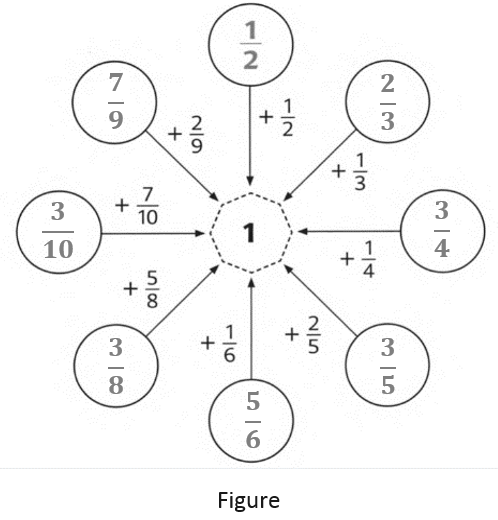Primary Mathematics Chapter 3 Fractions
Page 81 Exercise 3.1 Problem 1
Given: \(\frac{1}{2}\)= \(\frac{4}{8}\)
To find – The numerator by observing the given figure.
Here the number of black boxes denotes the numerator.
The number of black boxes + a number of white boxes denotes the denominator. (i.e. total number of boxes)
By observing the figure , \(\frac{1}{2}\)= \(\frac{4}{8}\)
The numerator by observing the given figure.\(\frac{1}{2}\)= \(\frac{4}{8}\)
Page 81 Exercise 3.1 Problem 2
Given: \(\frac{6}{10}=\frac{}{5}\)
To find the numerator by observing the given figure.
Here the number of black boxes denotes the numerator.
The number of black boxes + a number of white boxes denotes the denominator. (i.e. total number of boxes)
By observing the figure , \(\frac{6}{10}=\frac{3}{5}\)
The numerator by observing the given figure: \(\frac{6}{10}=\frac{3}{5}\)
Page 81 Exercise 3.1 Problem 3
Given: \(\frac{2}{3}=\frac{6}{}\)
To find -The denominator by observing the given figure.
Here the number of black boxes denotes the numerator.
The number of black boxes + a number of white boxes denotes the denominator. (i.e. total number of boxes)
By observing the figure \(\frac{2}{3}=\frac{6}{9}\)( Here the LHS is multiplied and divided by 3 to obtain the RHS)
The numerator by observing the given figure: \(\frac{2}{3}=\frac{6}{9}\)
Page 81 Exercise 3.1 Problem 4
Given: \(\frac{9}{12} = \frac{3}{}\)
To find – The denominator by observing the given figure.
Here the number of black boxes denotes the numerator.
The number of black boxes + a number of white boxes denotes the denominator. (i.e. total number of boxes)
By observing the figure, \(\frac{9}{12}=\frac{3}{4}\)
The numerator by observing the given figure: \(\frac{9}{12}=\frac{3}{4}\)
Page 81 Exercise 3.1 Problem 5
Given: \(\frac{1}{4}\)
To find – The equivalent fraction by observing the given figure.
Here the number of black boxes denotes the numerator.
The number of black boxes + a number of white boxes denotes the denominator. (i.e. total number of boxes)
By observing the figure, \(\frac{1}{4}\)= \(\frac{3}{12}\) ( Here the LHS is multiplied and divided by 3
to obtain the RHS)
The numerator by observing the given figure: \(\frac{1}{4}\)= \(\frac{3}{12}\)
Page 81 Exercise 3.1 Problem 6
Given: \(\frac{4}{5}\)
To find – The equivalent fraction by observing the given figure.
Here the number of black boxes denotes the numerator.
The number of black boxes + a number of white boxes denotes the denominator. (i.e. total number of boxes)
By observing the figure, \(\frac{4}{5}\)= \(\frac{8}{10}\)( Here the LHS is multiplied and divided by 2 to obtain the RHS)
The numerator by observing the given figure: \(\frac{4}{5}\)= \(\frac{8}{10}\)
Page 81 Exercise 3.1 Problem 7
Given: \(\frac{6}{12}\)
To find – The equivalent fraction by observing the given figure.
Here the number of black boxes denotes the numerator.
The number of black boxes + a number of white boxes denotes the denominator. (i.e. total number of boxes)
By observing the figure, \(\frac{6}{12}\)= \(\frac{1}{2}\) ( Here the RHS is multiplied and divided by 6
to obtain the LHS)
The equivalent fraction:\(\frac{6}{12}\)= \(\frac{1}{2}\)
Page 81 Exercise 3.1 Problem 8
Given: \(\frac{12}{6}\)
To find – The equivalent fraction by observing the given figure.
Here the number of black boxes denotes the numerator.
The number of black boxes + a number of white boxes denotes the denominator. (i.e. total number of boxes)
By observing the figure, \(\frac{12}{6}\)= \(\frac{3}{4}\) ( Here the RHS is multiplied and divided by 4
to obtain the LHS)
The equivalent fraction \(\frac{12}{6}\)= \(\frac{3}{4}\)
Page 82 Exercise 3.1 Problem 9
Given: Eight pairs of equivalent fractions have been given.
We have to join each pair with a straight line.
If we do it correctly, we will get four rectangles.

The eight pair of equivalent fractions joined:
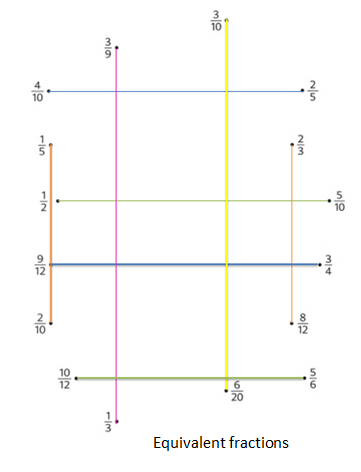
Page 83 Exercise 3.1 Problem 10
Given: \(\frac{1}{3}=\frac{2}{6}=\frac{3}{-}=\frac{}{12}\)
To find – The missing numerator and denominator in each set of equivalent fractions.
Let the missing denominator be x
Let the missing numerator be y.
The equation can be rewritten as \(\frac{1}{3}=\frac{2}{6}=\frac{3}{x}=\frac{y}{12}\)
Equating the first and the third fraction.
⇒ \(\frac{1}{3}\)= \(\frac{3}{x}\)
⇒ x = 9
Equating the first and the fourth fraction.
⇒ \(\frac{1}{3}\)=\(\frac{y}{12}\)
⇒ y \(\frac{12}{3}\)
⇒ y = 4
Substituting values of x and y
⇒ \(\frac{1}{3}=\frac{2}{6}=\frac{3}{x}=\frac{y}{12}\)
⇒ \(\frac{1}{3}=\frac{2}{6}=\frac{3}{9}=\frac{4}{12}\)
The missing numerator and denominator in each set of equivalent fractions ⇒ \(\frac{1}{3}=\frac{2}{6}=\frac{3}{9}=\frac{4}{12}\)
Page 83 Exercise 3.1 Problem 11
Given: \(\frac{5}{10}=\frac{4}{6}=\frac{4}{-}\)
To find – The missing numerator and denominator in each set of equivalent fractions.
Let the missing denominator be y
Let the missing numerator be x.
The equation can be rewritten as \(\frac{5}{10}=\frac{x}{6}=\frac{4}{y}\)
Equating the first and the second fraction.
⇒ \(\frac{5}{10}\)= \(\frac{x}{6}\)
⇒ x \(=\frac{6(5)}{10}\)
⇒ x = 3
Equating the first and the third fraction.
⇒ \(\frac{5}{10}\)\(=\frac{4}{y}\)
⇒ y \(=\frac{4(10)}{5}\)
⇒ y = 8
Substituting values of x and y
⇒ \(\frac{5}{10}=\frac{x}{6}=\frac{4}{y}\)
⇒ \(\frac{5}{10}=\frac{3}{6}=\frac{4}{8}\)
The missing numerator and denominator in each set of equivalent fraction
⇒ \(\frac{5}{10}=\frac{3}{6}=\frac{4}{8}\)
Page 83 Exercise 3.1 Problem 12
Given: \(\overline{12}=\frac{4}{-}=\frac{1}{4}\)
To find the missing numerator and denominator in each set of equivalent fractions.
Let the missing denominator be y
Let the missing numerator be x.
The equation can be rewritten as \(\frac{x}{12}=\frac{4}{y}=\frac{1}{4}\)
Equating the first and the third fraction.
⇒ \(\frac{x}{12}\) = \(\frac{1}{4}\)
⇒ x = \(\frac{12}{4}\)
⇒ x = 3
Equating the second and the third fraction.
⇒ \(\frac{4}{y}\)= \(\frac{1}{4}\)
⇒ y = 4(4)
⇒ y = 16
Substituting values of x and y
⇒ \(\frac{x}{12}=\frac{4}{y}=\frac{1}{4}\)
⇒ \(\frac{3}{12}=\frac{4}{16}=\frac{1}{4}\)
The missing numerator and denominator in each set of equivalent fractions ⇒\(\frac{3}{12}=\frac{4}{16}=\frac{1}{4}\)
Page 83 Exercise 3.1 Problem 13
Given: \(\frac{3}{-}=\frac{6}{8}=\frac{}{12}\)
To find – The missing numerator and denominator in each set of equivalent fractions.
Let the missing denominator be y
Let the missing numerator be x.
The equation can be rewritten as \(\frac{3}{y}=\frac{6}{8}=\frac{x}{12}\)
Equating the first and the second fraction.
⇒ \(\frac{3}{y}\)= \(\frac{6}{8}\)
⇒ y = \(\frac{3(8)}{6}\)
⇒ y = 4
Equating the second and the third fraction.
⇒ \(\frac{6}{8}\) = \(\frac{x}{12}\)
⇒ x = \(\frac{12(6)}{8}\)
⇒x = 9
Substituting values of x and y
⇒ \(\frac{3}{y}=\frac{6}{8}=\frac{x}{12}\)
⇒ \(\frac{3}{4}=\frac{6}{8}=\frac{9}{12}\)
The missing numerator and denominator in each set of equivalent fractions ⇒\(\frac{3}{4}=\frac{6}{8}=\frac{9}{12}\)
Page 83 Exercise 3.1 Problem 14
Given: \(\frac{12}{10}=\frac{10}{10}=\frac{}{8}\)
To find – The missing numerator and denominator in each set of equivalent fractions.
Let the missing denominator be y
Let the missing numerator be x.
The equation can be rewritten as \(\frac{12}{y}=\frac{10}{10}=\frac{x}{8}\)
Equating the first and the second fraction.
⇒ \(\frac{12}{y}\) = \(\frac{10}{10}\)
y = 12
Equating the second and the third fraction.
⇒ \(\frac{10}{10}\)= \(\frac{x}{8}\)
⇒ \(\frac{12}{12}\)=\(\frac{10}{10}\)=\(\frac{8}{8}\)
The missing numerator and denominator in each set of equivalent fractions ⇒ \(\frac{12}{12}\)=\(\frac{10}{10}\)=\(\frac{8}{8}\)
Page 84 Exercise 3.1 Problem 15
Given: \(\frac{9}{12}\)
To write – The fractions in their simplest form.
The given fraction can be written as ⇒ \(\frac{9}{12}\)= \(\frac{3×3}{3×4}\)
Canceling 3 in the numerator and the denominator
⇒ \(\frac{9}{12}\)= \(\frac{3}{4}\)
Therefore, the simplest form of ⇒ \(\frac{9}{12}\)= \(\frac{3}{4}\)
Page 84 Exercise 3.1 Problem 16
Given: \(\frac{8}{10}\)
To write – The fractions in their simplest form.
The given fraction can be written as
⇒ \(\frac{8}{10}\) = \(\frac{4×2}{5×2}\)
Canceling 2 in the numerator and the denominator
⇒ \(\frac{8}{10}\)= \(\frac{4}{5}\)
Therefore, the simplest form of ⇒ \(\frac{8}{10}\)= \(\frac{4}{5}\)
Page 84 Exercise 3.1 Problem 17
Given: \(\frac{10}{15}\)
To write – The fractions in their simplest form.
The given fraction can be written as
⇒ \(\frac{10}{15}\)= \(\frac{5×2}{5×3}\)
Canceling 5 in the numerator and the denominator
⇒ \(\frac{10}{15}\)= \(\frac{2}{3}\)
Therefore, the simplest form of \(\frac{10}{15}\)= \(\frac{2}{3}\)
Page 84 Exercise 3.1 Problem 18
Given: \(\frac{9}{18}\)
To write – The fractions in their simplest form.
The given fraction can be written as
⇒ \(\frac{9}{18}\) = \(\frac{9}{9(2)}\)
Canceling 2 in the numerator and the denominator
⇒ \(\frac{9}{18}\) = \(\frac{1}{2}\)
Therefore, the simplest form of ⇒ \(\frac{9}{18}\) = \(\frac{1}{2}\)
Page 84 Exercise 3.1 Problem 19
Given: \(\frac{8}{20}\)
To write – The fractions in their simplest form.
The given fraction can be written as
⇒ \(\frac{8}{20}\)= \(\frac{4×2}{4×5}\)
Canceling 2 in the numerator and the denominator,
⇒\(\frac{8}{20}\)= \(\frac{2}{5}\)
Therefore, the simplest form of ⇒\(\frac{8}{20}\)= \(\frac{2}{5}\)
Page 84 Exercise 3.1 Problem 20
Given: \(\frac{18}{24}\)
To write – The fractions in their simplest form.
The given fraction can be written as
⇒ \(\frac{18}{24}\)= \(\frac{6×3}{6×4}\)
Canceling 2 in the numerator and the denominator
⇒ \(\frac{18}{24}\)= \(\frac{3}{4}\)
Therefore, the simplest form of ⇒ \(\frac{18}{24}\)= \(\frac{3}{4}\)
Page 84 Exercise 3.1 Problem 21
Given: \(\frac{12}{30}\)
To write – The fractions in their simplest form.
The given fraction can be written as;
⇒ \(\frac{12}{30}\)= \(\frac{6×2}{6×5}\)
Canceling 6 in the numerator and the denominator,
⇒ \(\frac{12}{30}\)= \(\frac{2}{5}\)
Therefore, the simplest form of \(\frac{12}{30}\)= \(\frac{2}{5}\)
Page 84 Exercise 3.1 Problem 22
Given: \(\frac{20}{60}\)
To write – The fractions in their simplest form.
The given fraction can be written as;
⇒ \(\frac{20}{60}\)= \(\frac{10×2}{6×5×3}\)
Canceling 10 and 2 in the numerator and the denominator
⇒ \(\frac{20}{60}\) = \(\frac{2}{3}\)
Therefore, the simplest form of ⇒ \(\frac{20}{60}\) = \(\frac{2}{3}\)
Page 85 Exercise 3.2 Problem 1
Given: Fractional numbers \( \frac{5}{7}, \frac{5}{12}, \frac{11}{18}, \frac{12}{25}\)
The question is to find which of the fractions are greater than \(\frac{1}{2}\)
Compare the numerator and denominator. The fraction will be greater than \(\frac{1}{2}\) , If and only if the denominator is greater than 2×numerator
If we compare the numerator and denominator of each fraction
For, \(\frac{5}{7}\) denominator 7 is not greater than 2 × numerator
∴ So, it is not greater than \(\frac{1}{2}\)
For ,\(\frac{5}{12}\) , denominator 12 is greater than 2 × numerator
∴ So, it is greater than \(\frac{1}{2}\).
For , \(\frac{11}{18}\) denominator 18 is not greater than 2 × numerator
∴ So, it is not greater than \(\frac{1}{2}\).
\(\frac{12}{25}\) denominator 25 is greater than 2 × numerator
∴ So, it is greater than \(\frac{1}{2}\).
From the above step, it is clear that there are two numbers among the given fractions which are greater than \(\frac{1}{2}\)
They are \(\frac{5}{12}\) and \(\frac{12}{25}\)

Therefore, out of the given fractional numbers ,\( \frac{5}{7}, \frac{5}{12}, \frac{11}{18}, \frac{12}{25}\),the numbers that are greater than are circled.

Page 85 Exercise 3.2 Problem 2
Given: Fractional numbers \(\frac{1}{3}, \frac{1}{5}, \frac{12}{25}, \frac{5}{12}\)
The question is to find which of the fractions are greater than \(\frac{1}{4}\)
Compare the numerator and denominator. If the denominator is greater than 4 × numerator, then that value of the fraction will be greater than \(\frac{1}{4}\)
If we compare the numerator and denominator of each fraction
For \(\frac{1}{3}\), denominator 3 is not greater than 4 × numerator
∴ So, it is not greater than \(\frac{1}{4}\)
For, \(\frac{1}{5}\) , denominator 5 is greater than 4 × numerator
∴ So, it is greater than\(\frac{1}{4}\)
For, \(\frac{12}{25}\) , denominator 25 is not greater than 4 × numerator
∴ So, it is not greater than \(\frac{1}{4}\)
For , \(\frac{5}{12}\), denominator 12 is not greater than 4×numerator
∴ So, it is not greater than \(\frac{1}{4}\)
From the above step, it is clear that there are only one number among the given fractions which are greater than \(\frac{1}{4}\) It is \(\frac{1}{5}\)

Therefore, out of the given fractional numbers \(\frac{1}{3}, \frac{1}{5}, \frac{12}{25}, \frac{5}{12}\) the numbers that are greater than \(\frac{1}{4}\) are circled.

Page 85 Exercise 3.2 Problem 3
Given: Fractional numbers \(\frac{6}{7}, \frac{6}{8}, \frac{8}{9}, \frac{7}{8}\)
The question is to find which of the fractions are closer to 1.
Write the fraction in decimals and compare the answers.
Finding the decimal value of each fraction will give,
⇒ \(\frac{6}{7}\) = 0.8571
⇒ \(\frac{6}{8}\) = 0.75
⇒ \(\frac{8}{9}\) = 0.8889
⇒ \(\frac{7}{8}\) = 0.875
From the above values, the closest to 1 is 0.8889.
So, the fraction closest to 1 among the given fractional numbers is \(\frac{8}{9}\)

Therefore the fraction closest to 1 is \(\frac{8}{9}\)

Page 86 Exercise 3.2 Problem 4
Given: Fractional numbers \(\frac{3}{13}, \frac{8}{13}, \frac{5}{13}, \frac{11}{13}\)
The question is to arrange the given fractions in ascending order.
As all the denominators are the same, by comparing the numerator, the numbers can be arranged.
If all the denominators of the given numbers are same then the number with least numerator will be the smallest number.
While comparing the given numbers, they can be arranged in increasing order as,
⇒ \(\frac{3}{13}<\frac{5}{13}<\frac{8}{13}<\frac{11}{13}\)
Therefore, the given numbers can be arranged in increasing order as ⇒ \(\frac{3}{13}<\frac{5}{13}<\frac{8}{13}<\frac{11}{13}\)
Page 86 Exercise 3.2 Problem 5
Given: Fractional numbers \(\frac{2}{3}, \frac{2}{9}, \frac{2}{7}, \frac{2}{5}\)
Question is to arrange the given fractions in ascending order.
As all the numerators are same, by comparing the denominators, the numbers can be arranged.
If all the numerator of the given numbers are same then the number with the greatest denominator will be the smallest number.
While comparing the given numbers, they can be arranged in increasing order as,
⇒ \(\frac{2}{9}<\frac{2}{7}<\frac{2}{5}<\frac{2}{3}\)
Therefore, the given numbers can be arranged in increasing order as ⇒ \(\frac{2}{9}<\frac{2}{7}<\frac{2}{5}<\frac{2}{3}\)
Exercise 3.2 Page 86 Problem 6
Given: Fractional numbers \(\frac{2}{5}, \frac{3}{10}, \frac{7}{10}\)
The question is to arrange the given fractions in ascending order.
By finding LCM, make the denominators of all given fractions equal.
As all the denominators are the same, by comparing the numerator, the numbers can be arranged.
Make the denominators the same by finding the LCM.
LCM = 10
⇒ \(\frac{2×2}{5×2}\)\(\frac{3}{10}\), \( \frac{7}{10}\)
⇒ \(\frac{4}{10}\), \(\frac{3}{10}\), \( \frac{7}{10}\)
If all the denominators of the given numbers are the same then the number with the least numerator will be the smallest number.
While comparing the given numbers, they can be arranged in increasing order as,
⇒ \(\frac{3}{10}<\frac{4}{10}<\frac{7}{10}\)
⇒ \(\frac{3}{10}<\frac{4}{10}<\frac{7}{10}\)
Therefore, the given numbers can be arranged in increasing order ⇒ \(\frac{3}{10}<\frac{4}{10}<\frac{7}{10}\)
Page 86 Exercise 3.2 Problem 7
Given: Fractional numbers \(\frac{1}{2}, \frac{3}{4}, \frac{5}{12}\)
The question is to arrange the given fractions in ascending order.
By finding LCM, make the denominators of all given fractions equal.
As all the denominators are the same, by comparing the numerator, the numbers can be arranged.
Make the denominators the same by finding the LCM.
LCM = 2 × 2 × 3
LCM=12
Then the numbers will become
⇒ \(\frac{1×6}{2×6}\), \(\frac{3×3}{4×3}\), \(\frac{5}{12}\)
⇒ \(\frac{6}{12}\), \(\frac{9}{12}\), \(\frac{5}{12}\)
If all the denominators of the given numbers are same then the number w ⇒ ith least numerator will be the smallest number.
While comparing the given numbers, they can be arranged in increasing order as,
⇒ \(\frac{5}{12}<\frac{6}{12}<\frac{9}{12}\)
⇒ \(\frac{5}{12}<\frac{6}{12}<\frac{9}{12}\)
Therefore, the given numbers can be arranged in increasing order as ⇒ \(\frac{5}{12}<\frac{6}{12}<\frac{9}{12}\)
Page 86 Exercise 3.2 Problem 8
Given: Fractional numbers\(\frac{1}{8}\),\(\frac{2}{10}\), \(\frac{11}{12}\),\(\frac{3}{4}\)
The question is to arrange the given fractions in ascending order.
By finding LCM, make the denominators of all given fractions equal. As all the denominators are the same, by comparing the numerator, the numbers can be arranged.
Make the denominators the same by finding the LCM.
LCM =2 × 2 × 2 × 3 × 5
LCM = 120
Then the numbers will become
⇒ \(\frac{1×15}{8×15}\),\(\frac{2×12}{10×12}\),\(\frac{11×10}{12×10}\), \(\frac{3×30}{4×30}\)
⇒ \(\Rightarrow \frac{15}{120}, \frac{24}{120}, \frac{110}{120}, \frac{90}{120}\)
If all the denominators of the given numbers are the same then the number with the least numerator will be the smallest number.
While comparing the given numbers, they can be arranged in increasing order as,
⇒ \(\frac{15}{120}<\frac{24}{120}<\frac{90}{120}<\frac{110}{120}\)
⇒ \(\Rightarrow \frac{1}{8}<\frac{2}{10}<\frac{3}{4}<\frac{11}{12}\)
Therefore, the given numbers can be arranged in increasing order as ⇒ \(\frac{1}{8}<\frac{2}{10}<\frac{3}{4}<\frac{11}{12}\)
Exercise 3.2 Page 86 Problem 9
Given: Fractional numbers \(\frac{12}{15}, \frac{3}{5}, \frac{7}{15}, \frac{3}{7}\)
The question is to arrange the given fractions in ascending order.
By finding LCM, make the denominators of all given fractions equal
As all the denominators are the same, by comparing the numerator, the numbers can be arranged.
Make the denominators the same by finding the LCM.
LCM = 7 × 5 × 3
LCM = 105
Then the numbers will become
⇒ \(\frac{12×7}{15×7}\), \(\frac{3×21}{5×21}\), \(\frac{7×7}{15×7}\), \(\frac{3×15}{7×15}\)
⇒ \(\frac{84}{105}, \frac{63}{105}, \frac{49}{105}, \frac{45}{105}\)
If all the denominators of the given numbers are same then the number with least numerator will be the smallest number.
While comparing the given numbers, they can be arranged in increasing order as
⇒ \(\frac{45}{105}<\frac{49}{105}<\frac{63}{105}<\frac{84}{105}\)
⇒ \(\frac{3}{7}<\frac{7}{15}<\frac{3}{5}<\frac{12}{15}\)
Therefore, the given numbers can be arranged in increasing order as ⇒ \(\frac{3}{7}<\frac{7}{15}<\frac{3}{5}<\frac{12}{15}\)
Page 87 Exercise 3.3 Problem 1
Given: Margery has a 1 yd long ribbon that she wants to cut it into equal lengths that are either \(\frac{1}{6}\) yd, \(\frac{2}{6}\) yd, \(\frac{3}{6}\) y long.,
The question is to color the given figure to show different ways of getting it done and write addition equations.
The addition of a fractional number can be done by making their denominators same.
As the denominators are same here, just by adding directly, answers can be obtained.
There are 3 ways that Margery can cut this 1 yd ribbon into equal pices of length.
The first way is to cut the ribbon into 6 pieces of \(\frac{1}{6}\) yd length.
⇒ \(\frac{1}{6}+\frac{1}{6}+\frac{1}{6}+\frac{1}{6}+\frac{1}{6}+\frac{1}{6}=1\)
The second way is to cut the ribbon into 3 pieces of \(\frac{2}{6}\) yd length.
⇒ \(\frac{2}{6}\)+\(\frac{2}{6}\)+\(\frac{2}{6}\)= 1
The third way is to cut the ribbon into 3 pieces of \(\frac{3}{6}\) yd length.
⇒ \(\frac{3}{6}\)+ \(\frac{3}{6}\)= 1
It can be represented as

Therefore, Margery can cut the 1 yd ribbon into equal pieces of length in 3 different ways.
⇒ By cutting the ribbon into 6 pieces of \(\frac{1}{6}\) yd length.
⇒ By cutting the ribbon into 3 pieces of \(\frac{2}{6}\) yd length.
⇒ By cutting the ribbon into 2 pieces of \(\frac{3}{6}\) yd length.
Page 88 Exercise 3.3 Problem 2
Given: Figure

Question is to color the figure as \(\frac{2}{5}\) red and \(\frac{1}{5}\) yellow and add them.
Color the figure accordingly and add them by following properties of addition of fractional numbers.
Given figure colored according to the given fraction latex]\frac{2}{5}[/latex] red and \(\frac{1}{5}\) yellow Will be as follows
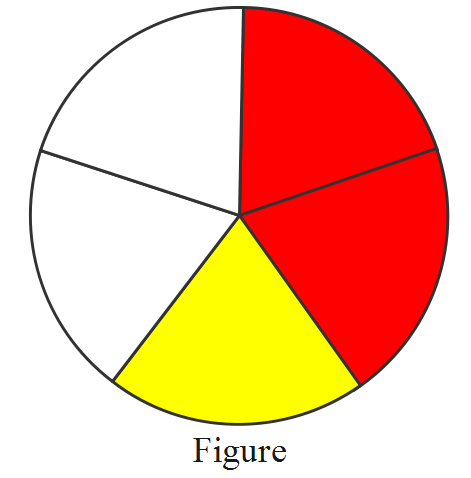
The denominator of the given numbers are equal. So, addition can be don directly.
Adding the numbers will give
⇒ \(\frac{2}{5}\) + \(\frac{1}{5}\)= \(\frac{3}{5}\)
Therefore, the sum of the given fractional numbers ⇒ \(\frac{2}{5}\) red and \(\frac{1}{5}\) yellow is \(\frac{3}{5}\).The figure is colored accordingly as
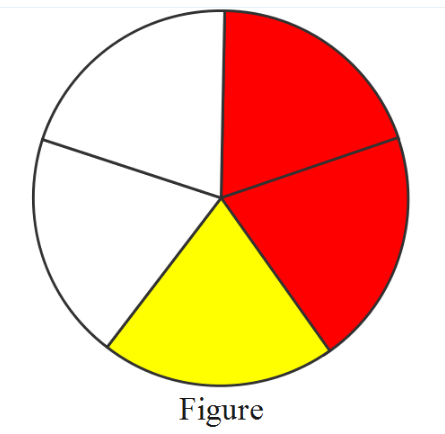
Page 88 Exercise 3.3 Problem 3
Given: Figure

Question is to color the figure as \(\frac{2}{8}\) blue and \(\frac{5}{8}\)green and add them.
Color the figure accordingly and add them by following properties of addition of fractional numbers.
Given figure colored according to the given fraction \(\frac{2}{8}\) blue and \(\frac{5}{8}\)green Will be as follows
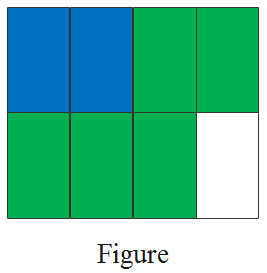
The denominator of the given numbers are equal.
So, addition can be don directly.
Adding the numbers will give
⇒ \(\frac{2}{8}\)+\(\frac{5}{8}\)= \(\frac{7}{8}\)
Therefore, the sum of the given fractional numbers\(\frac{2}{8}\) blue and \(\frac{5}{8}\)green is \(\frac{7}{8}\) The figure is colored accordingly as
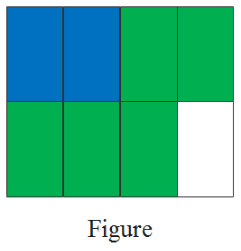
Page 88 Exercise 3.3 Problem 4
Given: Figure
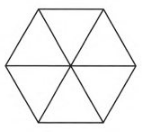
Question is to color the figure as \(\frac{3}{6}\) red and \(\frac{2}{6}\) blue and them.
Color the figure accordingly and add them by following properties of addition of fractional numbers.
Given figure colored according to the given fraction \(\frac{3}{6}\) red and \(\frac{2}{6}\) blue will be as follows
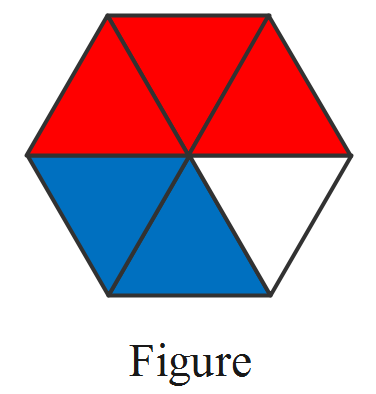
The denominator of the given numbers are equal. So, addition can be don directly.
Adding the numbers will give
⇒ \(\frac{3}{6}\)+ \(\frac{2}{6}\)= \(\frac{5}{6}\)
Therefore, the sum of the given fractional numbers ⇒ \(\frac{3}{6}\) red and \(\frac{2}{6}\) blue The figure is colored accordingly as

Page 88 Exercise 3.3 Problem 5
Given: Figure

Question is to color the figure as \(\frac{4}{10}\) yellow and \(\frac{3}{10}\) red and add them.
Color the figure accordingly and add them by following properties of addition of fractional numbers.
Given figure colored according to the given fraction \(\frac{4}{10}\) yellow and \(\frac{3}{10}\) red will be as follows
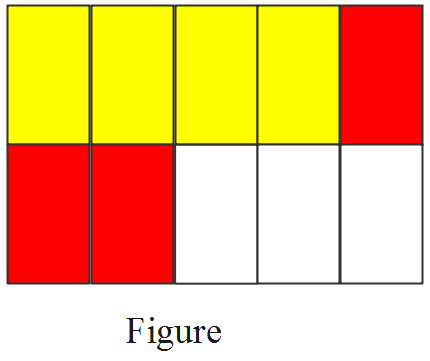
The denominator of the given numbers are equal. So, addition can be don directly.
Adding the numbers will give
\(\frac{4}{10}\) +\(\frac{3}{10}\)= \(\frac{7}{10}\)
Therefore, the sum of the given fractional numbers \(\frac{4}{10}\) yellow and \(\frac{3}{10}\) red is\(\frac{7}{10}\) The figure is colored accordingly as
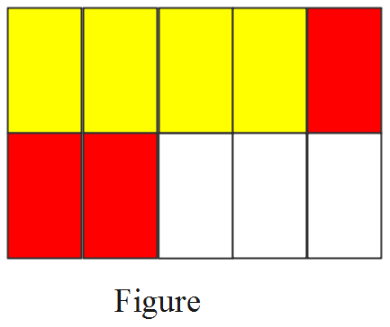
Page 89 Exercise 3.3 Problem 6
Given: A set of additions and a figure.
Question is to color the given figures that contain the answers of the given additions.
Addition of a fractional number can be done by making their denominators same.
As the denominators are same here, just by adding directly, answers can be obtained.
Addition of the given expression can be done a
1) \(\frac{1}{2}+\frac{1}{2}\)= 1
2) \(\frac{1}{4}\) + \(\frac{1}{4}\) = \(\frac{1}{2}\)
3) \(\frac{1}{3}\) + \(\frac{1}{3}\) = \(\frac{2}{3}\)
4) \(\frac{1}{5}\) + \(\frac{2}{5}\) = \(\frac{3}{5}\)
5) \(\frac{3}{6}\) + \(\frac{2}{6}\) = \(\frac{5}{6}\)
6) \(\frac{1}{7}\) + \(\frac{4}{7}\) = \(\frac{5}{7}\)
7) \(\frac{5}{8}\) + \(\frac{1}{8}\) = \(\frac{6}{8}\)
8) \(\frac{2}{9}\) + \(\frac{5}{9}\) = \(\frac{7}{9}\)
9) \(\frac{2}{10}+\frac{7}{10}\)= \(\frac{9}{10}\)
So, the answers of the given additions are 1, \(\frac{1}{2}\),\(\frac{2}{3}\),\(\frac{3}{5}\),= \(\frac{5}{6}\), \(\frac{5}{7}\) , \(\frac{7}{9}\), \(\frac{9}{10}\) and respectively.
Now, the number of legs of a spider can be found by coloring the figures that contain the answers.
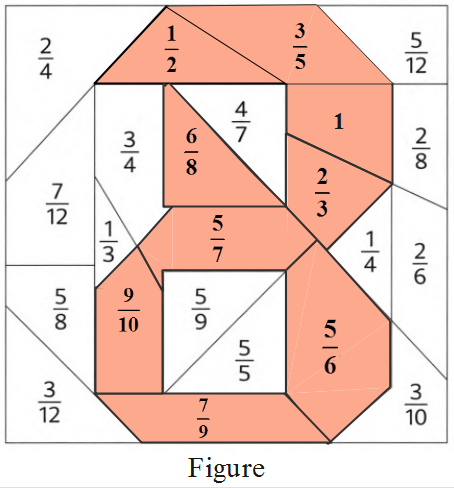
From the figure, after coloring, the number appearing is 8 . So, number of legs of a spider is 8.
Therefore, the answers of the given additions are 1, \(\frac{1}{2}\),\(\frac{2}{3}\),\(\frac{3}{5}\),= \(\frac{5}{6}\), \(\frac{5}{7}\), \(\frac{7}{9}\), \(\frac{9}{10}\) and respectively. After coloring the figures that contain the answers, the number of legs of a spider is obtained as 8.
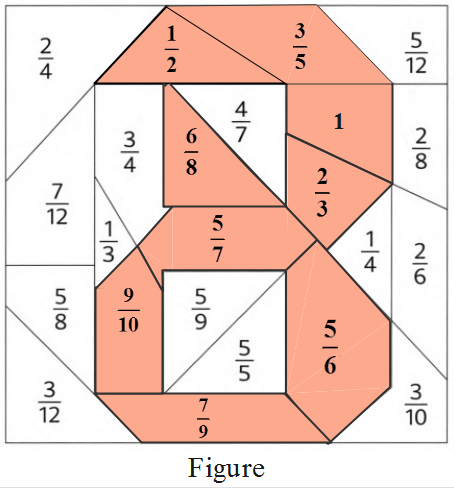
Page 90 Exercise 3.3 Problem 7
Given: Expression
\(\frac{1}{5}\)+\(\frac{1}{5}\)+\(\frac{1}{5}\) = ______
The question is to find the missing number by adding the given numbers.
The addition of a fractional number can be done by making their denominators the same.
As the denominators are the same here, just by adding directly, answers can be obtained.
The missing number can be found by adding the numerators directly as the denominators are the same.
⇒\(\frac{1}{5}\)+\(\frac{1}{5}\)+\(\frac{1}{5}\)=\(\frac{1+1+1}{5}\)
⇒ \(\frac{1}{5}\)+\(\frac{1}{5}\)+\(\frac{1}{5}\)= \(\frac{3}{5}\)
So the missing number is found to be \(\frac{3}{5}\).
Therefore, the missing number in the given expression\(\frac{1}{5}\)+\(\frac{1}{5}\)+\(\frac{1}{5}\)=______ is found to be ⇒ \(\frac{3}{5}\)
Page 90 Exercise 3.3 Problem 8
Given: Expression \(\frac{1}{5}\)+\(\frac{3}{5}\)+\(\frac{1}{5}\) =_____
The question is to find the missing number by adding the given numbers.
The addition of a fractional number can be done by making their denominators the same.
As the denominators are the same here, just by adding directly, answers can be obtained.
The missing number can be found by adding the numerators directly as the denominators
⇒ \(\frac{1}{5}\)+\(\frac{3}{5}\)+\(\frac{1}{5}\)=\(\frac{1+3+1}{5}\)
⇒ \(\frac{1}{5}\)+\(\frac{3}{5}\)+\(\frac{1}{5}\)= \(\frac{5}{5}\)
⇒ \(\frac{1}{5}\)+\(\frac{3}{5}\)+\(\frac{1}{5}\)=1
So the missing number is found to be 1.
Therefore, the missing number in the given expression \(\frac{1}{5}\)+\(\frac{3}{5}\)+\(\frac{1}{5}\)______ is found to be 1.
Page 90 Exercise 3.3 Problem 9
Given: Expression \(\frac{3}{8}\)+\(\frac{1}{8}\)+\(\frac{1}{8}\)=______
The question is to find the missing number by adding the given numbers.
The addition of a fractional number can be done by making their denominators the same.
As the denominators are the same here, just by adding directly, answers can be obtained.
The missing number can be found by adding the numerators directly as the denominators are the same.
⇒ \(\frac{3}{8}\)+\(\frac{1}{8}\)+\(\frac{1}{8}\)=\(\frac{3+1+1}{8}\)
⇒ \(\frac{3}{8}\)+\(\frac{1}{8}\)+\(\frac{1}{8}\)= \(\frac{5}{8}\)
So the missing number is found to be \(\frac{5}{8}\)
Therefore, the missing number in the given expression \(\frac{3}{8}\)+\(\frac{1}{8}\)+\(\frac{1}{8}\)=______ is found to be ⇒ \(\frac{5}{8}\).
Page 90 Exercise 3.3 Problem 10
Given: Expression \(\frac{1}{9}\)+\(\frac{2}{9}\)+\(\frac{4}{9}\)=______
The question is to find the missing number by adding the given numbers.
The addition of a fractional number can be done by making their denominators the same.
As the denominators are the same here, just by adding directly, answers can be obtained.
The missing number can be found by adding the numerators directly as the denominators are the same.
⇒ \(\frac{1}{9}\)+\(\frac{2}{9}\)+\(\frac{4}{9}\)= \(\frac{1+2+4}{9}\)
⇒ \(\frac{1}{9}\)+\(\frac{2}{9}\)+\(\frac{4}{9}\) = \(\frac{7}{9}\)
Therefore, the missing number in the given expression \(\frac{1}{9}\)+\(\frac{2}{9}\)+\(\frac{4}{9}\)=______ is found to be ⇒ \(\frac{7}{9}\)
Page 90 Exercise 3.3 Problem 11
Given: Expression \(\frac{2}{7}\)+ \(\frac{2}{7}\) + \(\frac{2}{7}\)=_______
The question is to find the missing number by adding the given numbers.
Addition of a fractional number can be done by making their denominators same.
As the denominators are same here, just by adding directly, answers can be obtained.
The missing number can be found by adding the numerators directly as the denominators are same.
⇒ \(\frac{2}{7}\)+ \(\frac{2}{7}\)+ \(\frac{2}{7}\)=\(\frac{2+2+2}{7}\)
⇒ \(\frac{2}{7}\)+ \(\frac{2}{7}\)+ \(\frac{2}{7}\) = \(\frac{6}{7}\)
So the missing number is found to be \(\frac{6}{7}\)
Therefore, the missing number in the given expression \(\frac{2}{7}\)+ \(\frac{2}{7}\)+ \(\frac{2}{7}\)=______ is found to be ⇒ \(\frac{6}{7}\)
Page 90 Exercise 3.3 Problem 12
Given: Expression \(\frac{5}{9}\)+ \(\frac{2}{9}\)+ \(\frac{2}{9}\)=______
The question is to find the missing number by adding the given numbers.
Addition of a fractional number can be done by making their denominators the same.
As the denominators are the same here, just by adding directly, answers can be obtained.
The missing number can be found by adding the numerators directly as the denominators are the same.
⇒\(\frac{5}{9}\)+ \(\frac{2}{9}\)+ \(\frac{2}{9}\)=\(\frac{5+2+2}{9}\)
⇒\(\frac{5}{9}\)+ \(\frac{2}{9}\)+ \(\frac{2}{9}\)= \(\frac{9}{9}\)
⇒\(\frac{5}{9}\)+ \(\frac{2}{9}\)+ \(\frac{2}{9}\)=1
So the missing number is found to be 1.
Therefore, the missing number in the given expression \(\frac{5}{9}\)+ \(\frac{2}{9}\)+ \(\frac{2}{9}\)=______ is found to be 1.
Page 90 Exercise 3.3 Problem 13
Given: Expression \(\frac{3}{10}\)+ \(\frac{2}{10}\)+ \(\frac{1}{10}\)=______
The question is to find the missing number by adding the given numbers.
Addition of a fractional number can be done by making their denominators same.
As the denominators are same here, just by adding directly, answers can be obtained.
The missing number can be found by adding the numerators directly as the denominators are same.
⇒\(\frac{3}{10}\)+ \(\frac{2}{10}\)+ \(\frac{1}{10}\)=\(\frac{3+2+1}{10}\)
⇒\(\frac{3}{10}\)+ \(\frac{2}{10}\)+ \(\frac{1}{10}\)= \(\frac{6}{10}\)
So the missing number is found to be \(\frac{6}{10}\)
Therefore, the missing number in the given expression \(\frac{3}{10}\)+ \(\frac{2}{10}\)+ \(\frac{1}{10}\)=______ is found to be \(\frac{6}{10}\)
Page 90 Exercise 3.3 Problem 14
Given: Expression \(\frac{5}{12}\)+ \(\frac{1}{12}\)+ \(\frac{3}{12}\)=______
The question is to find the missing number by adding the given numbers.
Addition of a fractional number can be done by making their denominators same.
As the denominators are same here, just by adding directly, answers can be obtained.
The missing number can be found by adding the numerators directly as the denominators are same.
⇒ \(\frac{5}{12}\)+ \(\frac{1}{12}\)+ \(\frac{3}{12}\)= \(\frac{5+1+3}{12}\)
⇒ \(\frac{5}{12}\)+ \(\frac{1}{12}\)+ \(\frac{3}{12}\)=\(\frac{9}{12}\)
So the missing number is found to be \(\frac{9}{12}\)
Therefore, the missing number in the given expression \(\frac{5}{12}\)+ \(\frac{1}{12}\)+ \(\frac{3}{12}\)=______ is found to be ⇒ \(\frac{9}{12}\)
Page 90 Exercise 3.3 Problem 15
Given: Figure
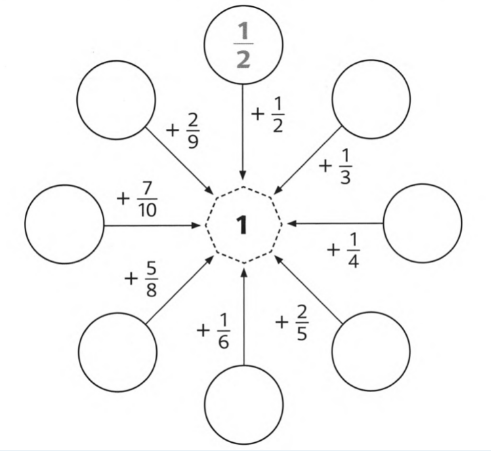
The question is to find the missing numbers by addition.
Addition of a fractional number can be done by making their denominators the same.
As the denominators are the same here, just by adding directly, answers can be obtained.
Finding the missing numbers in clockwise direction
let the missing numbers be denoted as x
1) x + \(\frac{1}{3}\) = 1
⇒ x = 1- \(\frac{1}{3}\)
⇒ x = \(\frac{2}{3}\)
2) x + \(\frac{1}{4}\) =1
⇒ x = 1− \(\frac{1}{4}\)
⇒ x = \(\frac{3}{4}\)
Similarly, the next missing numbers can be found by subtracting the given number from 1.
3) x = 1− \(\frac{2}{5}\)
⇒ x = \(\frac{3}{5}\)
4) x = 1− \(\frac{1}{6}\)
⇒ x = \(\frac{5}{6}\)
Further calculating
5) x = 1− \(\frac{5}{8}\)
x = \(\frac{3}{8}\)
6) x = 1\(\frac{7}{10}\)
x = \(\frac{3}{10}\)
7) x = 1− \(\frac{2}{9}\)
x = \(\frac{7}{9}\)
As all the answers are in their simplest form, the figure will look like

Therefore, the missing numbers in the given figure is obtained as
